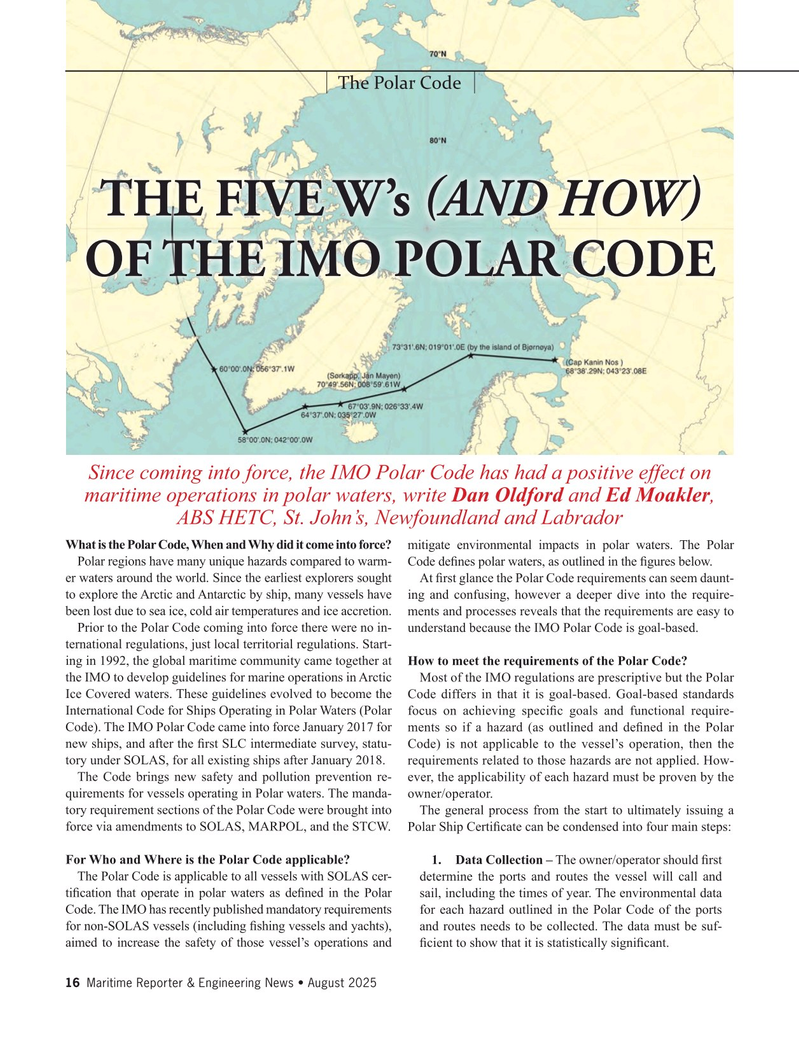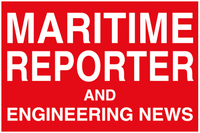
Page 16: of Maritime Reporter Magazine (August 2025)
Read this page in Pdf, Flash or Html5 edition of August 2025 Maritime Reporter Magazine
The Polar Code
THE FIVE W’s (AND HOW)
OF THE IMO POLAR CODE
Since coming into force, the IMO Polar Code has had a positive effect on maritime operations in polar waters, write Dan Oldford and Ed Moakler,
ABS HETC, St. John’s, Newfoundland and Labrador
What is the Polar Code, When and Why did it come into force? mitigate environmental impacts in polar waters. The Polar
Polar regions have many unique hazards compared to warm- Code de? nes polar waters, as outlined in the ? gures below.
er waters around the world. Since the earliest explorers sought At ? rst glance the Polar Code requirements can seem daunt- to explore the Arctic and Antarctic by ship, many vessels have ing and confusing, however a deeper dive into the require- been lost due to sea ice, cold air temperatures and ice accretion. ments and processes reveals that the requirements are easy to
Prior to the Polar Code coming into force there were no in- understand because the IMO Polar Code is goal-based.
ternational regulations, just local territorial regulations. Start- ing in 1992, the global maritime community came together at How to meet the requirements of the Polar Code?
the IMO to develop guidelines for marine operations in Arctic Most of the IMO regulations are prescriptive but the Polar
Ice Covered waters. These guidelines evolved to become the Code differs in that it is goal-based. Goal-based standards
International Code for Ships Operating in Polar Waters (Polar focus on achieving speci? c goals and functional require-
Code). The IMO Polar Code came into force January 2017 for ments so if a hazard (as outlined and de? ned in the Polar new ships, and after the ? rst SLC intermediate survey, statu- Code) is not applicable to the vessel’s operation, then the tory under SOLAS, for all existing ships after January 2018. requirements related to those hazards are not applied. How-
The Code brings new safety and pollution prevention re- ever, the applicability of each hazard must be proven by the quirements for vessels operating in Polar waters. The manda- owner/operator.
tory requirement sections of the Polar Code were brought into The general process from the start to ultimately issuing a force via amendments to SOLAS, MARPOL, and the STCW. Polar Ship Certi? cate can be condensed into four main steps:
For Who and Where is the Polar Code applicable? 1. Data Collection – The owner/operator should ? rst
The Polar Code is applicable to all vessels with SOLAS cer- determine the ports and routes the vessel will call and ti? cation that operate in polar waters as de? ned in the Polar sail, including the times of year. The environmental data
Code. The IMO has recently published mandatory requirements for each hazard outlined in the Polar Code of the ports for non-SOLAS vessels (including ? shing vessels and yachts), and routes needs to be collected. The data must be suf- aimed to increase the safety of those vessel’s operations and ? cient to show that it is statistically signi? cant.
16 Maritime Reporter & Engineering News • August 2025
MR #8 (1-17).indd 16 MR #8 (1-17).indd 16 8/4/2025 8:34:33 AM8/4/2025 8:34:33 AM

 15
15

 17
17
